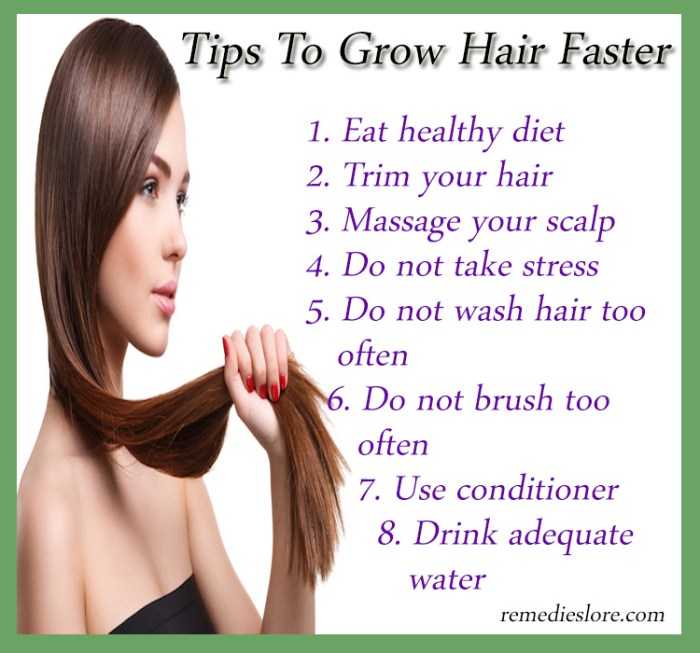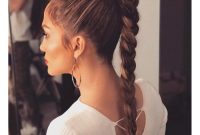The pursuit of longer, thicker hair is a universal desire, often influenced by cultural and societal standards of beauty. Understanding the natural growth cycle of hair and the factors that affect its length and thickness is essential for achieving this goal.
This comprehensive guide delves into the realm of hair growth, exploring nutrition, hair care routines, natural remedies, lifestyle factors, and medical treatments, empowering you with the knowledge and strategies to transform your hair.
Embark on a journey to discover the secrets of healthy hair growth, unraveling the intricate connection between diet, hair care practices, and overall well-being. Learn how to create a personalized hair care regimen that nourishes your scalp, strengthens your strands, and promotes optimal growth.
Discover the power of natural ingredients, lifestyle modifications, and medical interventions in unlocking your hair’s full potential.
Introduction
Hair, a defining attribute of our appearance, is often desired to be longer and thicker, symbolizing vitality and health. Understanding the natural growth cycle of hair and the factors that influence its length and thickness is crucial for developing effective hair care strategies.
Hair grows in cycles, consisting of three phases: anagen, catagen, and telogen. The anagen phase is the active growth phase, lasting 2-6 years, during which hair grows about 0.5 inches per month. The catagen phase is a transitional phase lasting about 2-3 weeks, where hair growth stops and the hair follicle shrinks.
Finally, the telogen phase is the resting phase, lasting about 3-4 months, after which the hair falls out and the cycle repeats.
Factors Affecting Hair Growth
Several factors can affect the length and thickness of hair, including genetics, age, nutrition, and hair care practices.
- Genetics: Hair growth is largely determined by genetics, including hair texture, thickness, and growth rate.
- Age: As we age, hair growth slows down, and hair may become thinner and weaker.
- Nutrition: A balanced diet rich in vitamins, minerals, and proteins is essential for healthy hair growth. Specific nutrients like biotin, iron, and zinc are particularly important.
- Hair Care Practices: Proper hair care practices, such as gentle brushing, avoiding tight hairstyles, and using appropriate hair care products, can help promote hair growth and prevent damage.
Nutrition and Diet

The saying “You are what you eat” holds true for your hair as well. A balanced diet that provides your body with the necessary nutrients is essential for healthy hair growth. Certain vitamins, minerals, and nutrients play a crucial role in maintaining healthy hair and promoting growth.
Essential Nutrients for Hair Health
- Protein: Protein is the building block of hair. It provides the amino acids necessary for hair growth and strength. Good sources of protein include lean meats, fish, eggs, dairy products, beans, and nuts.
- Biotin: Biotin, also known as vitamin B7, is essential for healthy hair, skin, and nails. It helps in the production of keratin, a protein that makes up hair. Good sources of biotin include eggs, liver, avocado, and almonds.
- Iron: Iron is necessary for red blood cell production, which carries oxygen to the hair follicles. Iron deficiency can lead to hair loss and brittle hair. Good sources of iron include red meat, poultry, seafood, beans, and leafy green vegetables.
- Zinc: Zinc is involved in various cellular processes, including hair growth. It helps in the production of DNA and proteins necessary for hair growth. Good sources of zinc include oysters, beef, lamb, nuts, and beans.
- Omega-3 Fatty Acids: Omega-3 fatty acids are essential fatty acids that the body cannot produce on its own. They play a role in hair growth and health. Good sources of omega-3 fatty acids include fatty fish (salmon, tuna, mackerel), flaxseeds, walnuts, and chia seeds.
Incorporating Specific Foods and Supplements for Hair Growth
In addition to a balanced diet, certain foods and supplements can be beneficial for hair growth:
- Green Tea: Green tea contains antioxidants that can help protect hair follicles from damage. It also contains caffeine, which may stimulate hair growth.
- Aloe Vera: Aloe vera gel has anti-inflammatory and antibacterial properties that can help soothe the scalp and promote hair growth. It can be applied directly to the scalp or taken as a supplement.
- Fenugreek: Fenugreek seeds contain nutrients that may help promote hair growth. They can be soaked overnight and consumed in the morning or taken as a supplement.
- Saw Palmetto: Saw palmetto is a plant that has been used traditionally to treat hair loss. It may help inhibit the production of DHT, a hormone that can contribute to hair loss.
It’s important to note that individual results may vary, and consulting a healthcare professional before taking any supplements is always advisable.
Hair Care Routine
Establishing a consistent hair care routine is essential for promoting healthy hair growth. A well-rounded routine can help maintain a healthy scalp environment, prevent damage, and provide the nutrients necessary for optimal hair growth. Here’s a step-by-step guide to a comprehensive hair care routine:
Washing and Conditioning
Regularly washing and conditioning your hair is crucial for maintaining a clean and healthy scalp. Choose a shampoo and conditioner suitable for your hair type and concerns. Wash your hair 2-3 times a week, or as needed, using lukewarm water.
Apply conditioner to the ends of your hair, avoiding the scalp, and leave it on for a few minutes before rinsing thoroughly.
Detangling and Brushing
Detangling and brushing your hair gently helps prevent breakage and promotes even distribution of natural oils. Start by detangling your hair with a wide-toothed comb or detangling brush while it’s wet. Once detangled, use a soft-bristled brush to brush your hair from the ends to the roots.
Avoid brushing your hair when it’s dry, as this can cause breakage.
Deep Conditioning and Hair Masks
Deep conditioning and hair masks provide intense nourishment and hydration to your hair. Deep conditioning treatments can be done once or twice a month, depending on your hair’s needs. Apply a deep conditioner to your hair, cover it with a shower cap, and leave it on for the recommended time.
Rinse thoroughly afterward. Hair masks can be used more frequently, such as once a week, to address specific hair concerns like dryness, damage, or frizz.
Trimming and Split End Management
Regular trims are essential for maintaining healthy hair growth. Trimming helps remove split ends, which can cause breakage and prevent healthy growth. Aim to trim your hair every 6-8 weeks, or more frequently if you have split ends. Split ends can also be managed by using a leave-in conditioner or hair oil to the ends of your hair.
Natural Remedies and Home Treatments
Harnessing the power of nature’s bounty, numerous natural remedies and home treatments have been employed for centuries to promote hair growth and enhance its overall health. These remedies, often rooted in traditional practices and passed down through generations, utilize the inherent properties of plants, herbs, and botanicals to nourish and stimulate hair follicles, resulting in longer, thicker, and healthier locks.
DIY Hair Growth Recipes
Coconut Oil: Renowned for its moisturizing and nourishing properties, coconut oil is a staple in many hair care regimens. Its rich composition of fatty acids, including lauric acid, penetrates deep into the hair shaft, providing intense hydration and reducing protein loss.
Additionally, coconut oil possesses antimicrobial and antifungal properties, aiding in the maintenance of a healthy scalp environment.
- Method: Warm a small amount of coconut oil in your hands until it melts. Massage it thoroughly into your scalp, ensuring that it reaches the roots of your hair. Leave it on for at least 30 minutes, or overnight for deeper conditioning. Rinse it out with a mild shampoo and lukewarm water.
- Benefits: Coconut oil helps to strengthen hair strands, reduce breakage, and promote hair growth. Its nourishing properties help to improve the overall health and appearance of your hair.
Aloe Vera: Known for its soothing and healing properties, aloe vera is an excellent remedy for a variety of scalp conditions that can hinder hair growth. Its anti-inflammatory properties help to reduce scalp irritation and inflammation, while its moisturizing and hydrating properties promote a healthy scalp environment.
- Method: Extract the gel from an aloe vera leaf and apply it directly to your scalp. Massage it in gently and leave it on for at least 30 minutes, or overnight. Rinse it out with a mild shampoo and lukewarm water.
- Benefits: Aloe vera helps to soothe and cool the scalp, reduce inflammation, and promote hair growth. It also helps to strengthen hair strands and reduce breakage.
Castor Oil: Extracted from the castor bean plant, castor oil is a thick, viscous oil that has been used for centuries to promote hair growth. It is rich in ricinoleic acid, a fatty acid that has been shown to stimulate hair growth and improve scalp health.
- Method: Apply castor oil directly to your scalp and massage it in gently. Leave it on for at least 30 minutes, or overnight. Rinse it out with a mild shampoo and lukewarm water.
- Benefits: Castor oil helps to stimulate hair growth, strengthen hair strands, and reduce breakage. It also helps to improve scalp health and reduce inflammation.
Lifestyle Factors

Your lifestyle choices can significantly impact the health and growth of your hair. Understanding the role of stress, sleep, exercise, and hormonal imbalances in hair growth can help you make informed decisions to promote thicker, longer locks.
Stress and Hair Growth
Chronic stress can take a toll on your overall health, including your hair. When you’re stressed, your body produces the hormone cortisol, which can disrupt the hair growth cycle and lead to hair loss. Additionally, stress can cause scalp tension, which can also contribute to hair loss.
Sleep and Hair Growth
Getting enough quality sleep is crucial for overall health, including hair growth. During sleep, your body produces hormones that promote hair growth. When you don’t get enough sleep, your body doesn’t have enough time to produce these hormones, which can lead to slower hair growth.
Exercise and Hair Growth
Regular exercise is beneficial for overall health and can also promote hair growth. Exercise helps to improve blood circulation, which brings nutrients and oxygen to the hair follicles, supporting healthy hair growth. Additionally, exercise can help to reduce stress, which, as discussed earlier, can contribute to hair loss.
Hormonal Imbalances and Hair Loss
Hormonal imbalances, such as those caused by thyroid problems or menopause, can lead to hair loss. Thyroid hormones play a role in regulating hair growth, and an imbalance can disrupt the hair growth cycle. Similarly, hormonal changes during menopause can cause hair loss in some women.
Tips for Managing Stress, Improving Sleep, and Incorporating Exercise
- To manage stress, try relaxation techniques such as yoga, meditation, or deep breathing exercises.
- Aim for 7-8 hours of quality sleep each night. Establish a regular sleep routine and create a conducive sleep environment.
- Incorporate regular exercise into your routine. Aim for at least 30 minutes of moderate-intensity exercise most days of the week.
By managing stress, improving sleep quality, and incorporating exercise into your routine, you can support overall health and create an environment conducive to healthy hair growth.
Medical Treatments and Procedures
Advances in medical science have introduced various treatments and procedures to address hair loss and promote hair growth. These options range from topical treatments to laser therapy, microneedling, platelet-rich plasma (PRP) treatments, and even surgical interventions like hair transplants.
Topical Treatments
Topical treatments, applied directly to the scalp, play a crucial role in stimulating hair growth and preventing further hair loss. One of the most widely used topical treatments is minoxidil, available in both over-the-counter and prescription strengths. Minoxidil works by increasing blood flow to the hair follicles, providing essential nutrients for hair growth.
Laser Therapy
Laser therapy involves the use of low-level lasers to stimulate hair growth. This non-invasive procedure works by increasing blood circulation to the scalp, promoting the delivery of nutrients to the hair follicles, and stimulating dormant follicles to enter the growth phase.
Microneedling and Platelet-Rich Plasma (PRP) Treatments
Microneedling involves creating tiny punctures in the scalp using fine needles, triggering the body’s natural healing response. This process stimulates blood flow, promotes the release of growth factors, and enhances the absorption of topical treatments. Platelet-rich plasma (PRP) treatments involve injecting a concentrated solution of platelets and growth factors into the scalp.
PRP promotes tissue regeneration, stimulates hair growth, and improves the overall health of the scalp.
Hair Transplant Procedures
Hair transplant procedures involve surgically removing hair follicles from a donor area, typically the back of the head, and transplanting them to the balding or thinning areas of the scalp. This procedure is effective in restoring hair growth in areas where hair follicles are no longer active.
Protective Hairstyles and Styling Techniques
Embracing protective hairstyles and styling techniques is crucial for minimizing breakage, promoting hair growth, and maintaining healthy, resilient hair. Avoiding tight hairstyles, heat styling tools, and harsh chemicals is essential to prevent damage and allow hair to thrive.
Protective Hairstyles
Protective hairstyles shield hair from external stressors, reduce manipulation, and promote growth. Examples include braids, twists, cornrows, buns, and updos. These styles keep hair secured and prevent tangles, knots, and breakage.
Benefits of Avoiding Tight Hairstyles
Tight hairstyles, such as ponytails, tight buns, and cornrows, can cause tension on the scalp and hair follicles, leading to breakage and hair loss. Avoiding tight hairstyles allows the scalp to breathe, promotes blood circulation, and encourages healthy hair growth.
Avoiding Heat Styling Tools and Harsh Chemicals
Heat styling tools, such as blow dryers, flat irons, and curling irons, can cause significant damage to hair. High temperatures can strip hair of its natural oils, making it dry, brittle, and prone to breakage. Similarly, harsh chemicals found in hair dyes, relaxers, and perms can weaken hair structure and lead to breakage.
Creating Gentle and Protective Hairstyles
* Use soft, satin or silk scrunchies or hair ties to avoid breakage.
- Avoid tight braids or buns; leave some slack to prevent tension on the scalp.
- Opt for loose, natural hairstyles that allow hair to move freely.
- Incorporate regular scalp massages to stimulate blood flow and promote hair growth.
Patience and Consistency
Achieving long-term hair growth results requires patience and unwavering consistency. Hair growth is a natural process that takes time, and visible improvements may not be immediate. It’s crucial to maintain a healthy hair care routine and lifestyle habits over an extended period to witness significant changes.
The average rate of hair growth is about 0.5 inches per month. This means that it can take several months or even years to achieve noticeable length. However, by following a consistent hair care regimen and making healthy lifestyle choices, you can optimize your hair’s growth potential and expedite the process.
Setting Realistic Expectations
Setting realistic expectations is key to maintaining motivation and avoiding disappointment. Understand that hair growth is a gradual process, and results may vary depending on individual factors such as genetics, age, and overall health. Avoid comparing your progress to others, as everyone’s hair growth journey is unique.
Consistency in Hair Care Routine
Consistency in your hair care routine is paramount for long-term hair growth success. This includes regular cleansing, conditioning, and deep conditioning treatments. Choose hair care products that are specifically designed for your hair type and concerns. Avoid harsh chemicals and excessive heat styling, as these can damage hair and hinder growth.
Patience and Perseverance
Patience and perseverance are essential virtues in the hair growth journey. It’s easy to get discouraged if you don’t see immediate results, but it’s important to remember that hair growth takes time. Stay committed to your hair care routine and healthy lifestyle choices, and you will eventually see the desired results.
Summary
Achieving longer, thicker hair is a gradual process that requires patience, consistency, and a holistic approach to hair care. By nourishing your body with a balanced diet, implementing a gentle hair care routine, and addressing underlying lifestyle factors, you can create an environment conducive to healthy hair growth.
Embrace the journey, celebrate the small victories along the way, and witness the transformation of your hair as it reaches its fullest potential.
Common Queries
Q: How long does it take to see results from hair growth treatments?
A: The timeline for visible results varies depending on the individual and the specific treatment used. Generally, it can take several months of consistent use before noticeable changes become apparent.
Q: Can stress impact hair growth?
A: Yes, stress can negatively affect hair growth. Chronic stress can disrupt the hair growth cycle, leading to hair loss or slower growth rates.
Q: Is it necessary to trim split ends regularly?
A: Trimming split ends is essential for maintaining healthy hair growth. Split ends can travel up the hair shaft, causing breakage and hindering growth. Regular trims prevent this issue and promote stronger, healthier hair.
Q: How often should I wash my hair?
A: The frequency of hair washing depends on your hair type and scalp condition. Generally, washing your hair every 2-3 days is sufficient to maintain a healthy balance of natural oils and prevent scalp buildup.



